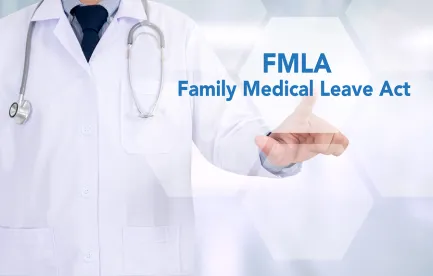On March 18, 2020, President Trump signed into law the “Families First Coronavirus Response Act,” (the Act). This Act is a broad response to many of the challenges caused by the current and impending spread of the Coronavirus Disease 2019 (COVID-19). The Families First Coronavirus Response Act has eight provisions intended to assist people during the public health emergency caused by COVID-19 and to allocate federal funds intended to provide such assistance. This GT Alert addresses two of the eight provisions of the Act that require certain private employers to provide paid leave to employees who cannot work because of coronavirus and/or the public health emergency surrounding it. Specifically, this Alert will address the Emergency Paid Sick Leave Act (Division E) and the Emergency Family and Medical Leave Expansion Act (Division C). This Alert supersedes our previous Alerts reporting on the versions of H.R. 2601 which led to the Act.
In combination, the Emergency Family and Medical Leave Expansion Act and the Emergency Paid Sick Leave Act may require certain private employers with fewer than 500 employees to provide up to 14 total weeks of leave, 12 weeks of which must be paid leave. Such paid leave is required for employees whose absences from work become necessary due to COVID-19 and its consequences. All new requirements on private employers will take effect 15 days after “final enactment” of the Act (presumably April 2, 2020) and continue through Dec. 31, 2020.
THE EMERGENCY PAID SICK LEAVE ACT (DIVISION E)
The Families First Coronavirus Response Act establishes a brand new federal obligation, applicable to all private employers with fewer than 500 employees, to provide up to 80 hours of paid sick time for full-time employees, and paid sick time equal to the hours each part-time employee works in the average two-week period, for those employees “who are unable to work (or telework) due to a need for leave” for any of the following six reasons:
-
The employee is subject to a federal, state, or local quarantine or isolation order related to COVID-19;
-
The employee has been advised by a health care provider to self-quarantine due to concerns related to COVID-19;
-
The employee is experiencing symptoms of COVID-19 and seeking medical diagnosis;
-
The employee is caring for an individual who is subject to a federal, state, or local quarantine order, or an individual who has been advised to self-quarantine due to concerns related to COVID-19;
-
The employee is caring for the employee’s son or daughter, if the child’s school or child care facility has been closed, or the child’s care provider is unavailable due to COVID-19 precautions; or
-
The employee is experiencing any other substantially similar condition specified by Health and Human Services in consultation with the Department of the Treasury and the Department of Labor.
Emergency sick time relating to an employee’s own condition (see 1-3 above) is calculated based on the employee’s regular rate of pay or applicable minimum wage, whichever is greater, but is limited to $511 per day and $5,110 total.
Emergency sick time relating to situations where the employee is acting as a caregiver (see 4-6 above) is calculated based on two-thirds of the employee’s regular rate of pay or applicable minimum wage, whichever is greater, but is limited to $200 per day and $2,000 total.
The only portion of Emergency Paid Sick Leave Act which indicates how employees must advise employers of their need for emergency paid sick leave, or what employers may require of employees who do so, is a provision which states “[a]fter the first workday (or portion thereof) an employee receives paid sick time under the Act, an employer may require the employee to follow reasonable notice procedures in order to continue receiving such paid sick time.” Employers should also note the following:
-
Employees are entitled to use the full amount of their emergency paid sick time, regardless of the duration of their employment.
-
Emergency paid sick time is in addition to, and may be used before, any paid sick time or other paid leave (e.g., vacation or PTO) that the employer otherwise provides to employees.
-
Employers are prohibited from requiring any employee to use paid leave provided by employer before using emergency paid sick leave;
-
Employers must post a notice of the requirements of the Emergency Paid Sick Time Act (to be prepared by the Department of Labor) in conspicuous places where notices to employees are typically posted.
-
Under certain circumstances, an employer who is a party to a multiemployer collective bargaining agreement may fulfill its obligations to provide paid sick time by making an equivalent contribution to the plan fund.
-
Employers may not retaliate or discriminate against any employee who uses emergency paid sick time or has filed a complaint or testified in a proceeding relating to the Emergency Paid Sick Time Act.
Violations of the Emergency Paid Sick Time Act may be treated as a Violation of the Fair Labor Standards Act of 1938 (29 U.S.C. §206) (FLSA), and employers may be subject to substantial penalties under that Act, which may include liquidated damages and fines, among other consequences.
EMERGENCY FAMILY AND MEDICAL LEAVE EXPANSION ACT (DIVISION C)
The Families First Coronavirus Response Act also adds a new statutory basis (Section 102(a)(1)(F)) for leave under the Family Medical Leave Act (FMLA), providing up to 12 weeks of Emergency FMLA leave to eligible employees who are “unable to work (or telework) due to a need for leave to care for the son or daughter under 18 years of age of such employee if the school or place of care has been closed, or the child care provider of such son or daughter is unavailable, due to a public health emergency.”
The Emergency Family and Medical Leave Expansion Act provides that the first 10 days of Emergency FMLA leave may be unpaid. Employees may choose (but cannot be forced) to substitute any accrued paid vacation leave, personal leave, or medical or sick leave (including paid leave under the Emergency Paid Sick Time Act) to which they are otherwise entitled for unpaid leave during this initial 10 days of Emergency FMLA. Thereafter, covered employers must provide eligible employees with up to ten (10) weeks of Emergency FMLA leave, paid at two-thirds of the employees’ regular rate of pay, up to $200 per day and $10,000 total. Under certain circumstances, an employer who is a party to a multiemployer collective bargaining agreement may fulfill its obligations to provide paid Emergency FMLA by making an equivalent contribution to the plan fund.
This new Section on Emergency FMLA, like the Emergency Paid Sick Leave Act, only applies to private employers with fewer than 500 employees. Unlike the Emergency Paid Sick Leave Act, however, which adopts the FLSA’s broad definition of “employee,” Emergency FMLA is available only to those employees who have worked at their employers for at least 30 days at the time of their leave request. Mirroring usual reinstatement rights elsewhere in the FMLA, employers with between 25 and 500 employees must restore employees returning from Emergency FMLA to their same job or an equivalent position if the employee’s position is no longer available. However, an employer with fewer than 25 employees may not be required to return an employee taking Emergency FMLA to work if: (1) the employee’s job no longer exists due to economic conditions or changes in operational conditions caused by the public health emergency during the Emergency FMLA period; and (2) the employer has made reasonable effort to find the same or equivalent position for the employee. In such a case, the employer must contact the employee if an equivalent position becomes available within one year of the date on which the employee’s Emergency FMLA ends. The Act also exempts certain small employers from civil actions by employees otherwise allowed by the FMLA.
Finally, and perhaps most notably from a practical perspective, The Emergency Family and Medical Leave Expansion Act is silent and/or ambiguous in two areas which, unless clarified by the Department of Labor, may be of significant concern to covered employers attempting to incorporate administration of the new Emergency FMLA rights:
-
The Act does not define how or whether a covered employer is entitled to receive information and/or documentation from an eligible employee of the employee’s need to take the new Emergency FMLA.
-
The Act does not specify whether current employees who have already used some or all of their 12-week FMLA entitlement for other permissible reasons under the FMLA should be deemed to have only what remains of that original 12 weeks of FMLA entitlement to use as Emergency FMLA, or whether they will have a fresh 12 weeks of Emergency FMLA with the enactment of the new law.
PROVISIONS COMMON TO BOTH NEW LAWS
In addition to the above, there are three new features applicable to both the Emergency Paid Sick Leave Act and the Emergency Family and Medical Leave Expansion Act:
-
Health care providers or emergency responders may elect to exclude certain employees from the Act.
-
The Department of Labor is authorized to issue regulations which, among other things: (1) exclude health care workers and emergency responders from eligibility for emergency paid sick time; and (2) exempt businesses with fewer than 50 employees when providing Emergency Paid Sick Time or Emergency Paid FMLA would jeopardize the viability of the business.
-
The caps on both Emergency FMLA and Emergency Paid Sick Time are consistent with the refundable tax credits for employers that are described in Division G of the Families First Coronavirus Response Act.
CONCLUSION
The Families First Coronavirus Response Act is the first federal law mandating employers to provide paid time off to employees. Although providing relief to employees who require time off due to COVID-19 and it many effects, the Act will add to the challenges faced by many employers coping with the current public health emergency.




 />i
/>i

